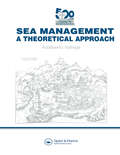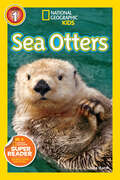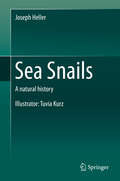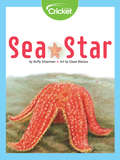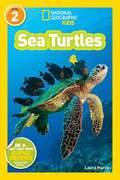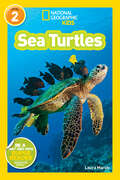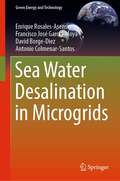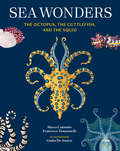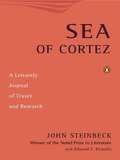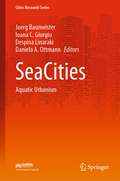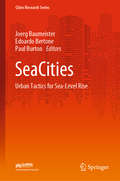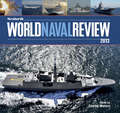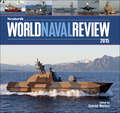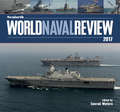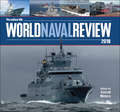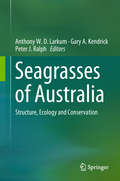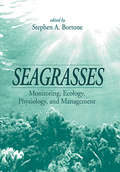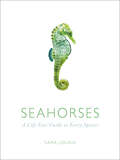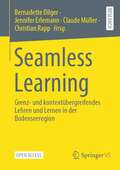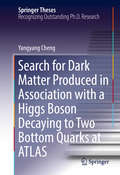- Table View
- List View
Sea Mammals: The Past and Present Lives of Our Oceans’ Cornerstone Species
by Annalisa BertaA richly illustrated introduction to the world’s living and extinct sea mammalsFrom the gregarious sea otter and playful dolphins to the sociable narwhal and iconic polar bear, sea mammals are a large, diverse, and increasingly precious group. In this book, Annalisa Berta, a leading expert on sea mammals and their evolution, presents an engaging and richly illustrated introduction to past and present species of these remarkable creatures, from the blue whale and the northern fur seal to the extinct giant sperm whale, aquatic sloth, and walking sea cow.The book features more than 50 individual species profiles, themed chapters, stunning photographs, and specially commissioned paleo-illustrations of extinct species. It presents detailed accounts of these mammals’ evolutionary path, anatomy, behavior, habitats, and conservation. And because these are key species that complete many food chains and have the widest influence of all sea life, the book also offers insights into a broad variety of marine worlds today and in the future.
Sea Management: A theoretical approach
by Adalberto VallegaThis book has been conceived with the aim of contributing to the International Conference on Ocean Management in Global Change [Genoa, June 22-26, 1992] and to the ocean sciences' debate on the conceptual framework and targets of sea management.
Sea Otters (Readers)
by Laura MarshIn this level 1 reader, young readers will explore the fun-filled world of lovable otters. Follow these playful critters through their aquatic habitats, learn how otters raise their young, and discover their curious and social natures. Beautiful photos and carefully leveled text make this book perfect for reading aloud or for independent reading.
Sea Snails
by Joseph HellerThis richly illustrated book presents the diversity and natural history of sea snail groups. By integrating aspects of morphology, ecology, evolution and behaviour, it describes how each group copes with problems of defence, locomotion, nutrition, reproduction and embryonic development. First come general characteristics of the Mollusca, to which snails belong; and next, characteristics by which snails (Gastropoda) differ from other molluscs. Then a broad, panoramic view of all major sea snail groups, from the primitive to the more advanced, is presented, including both the more abundant and some remote ones of special interest. In detailing primitive sea snails, first limpets (Patellogastropoda) are described, followed by brush snails (Vetigastropoda: top-shells, turbans and allies) and nerites (Neritimorpha), a small group with remarkably high variation in shell colour and in habitats. In looking at advanced-snails (Caenogastropoda), it details the herbivorous grazers and filter-feeders and the many voracious predators, some which use venomous darts. The book also covers sea slugs (Opisthobranchia), which have shifted from mechanical to chemical defence; some are herbivores, some use their food to harness solar energy, others are predators that gain stinging cells and poisonous compounds from their food. In addition, readers will learn about aspects of sea snails in human culture, including use as sacred artefacts and objects of magic and money, as a source of the royal and sacred dyes of purple and blue and as holy ceremonial trumpets. The text, in which scientific terms are accompanied by parallel common ones, is accompanied by over 200 illustrations (mostly in colour). This comprehensive, insightful portrait of sea snails will appeal to marine biologists, zoology lecturers and students, biology teachers, field-school instructors, nature reserve wardens, amateur naturalists, as well as to lecturers and learners of human culture.
Sea Star
by Buffy SilvermanHave you ever seen a sea star before? They are the pretty star-shaped creatures that hang out at the bottom of the ocean. Learn about Sea Star as she finds and eats her favorite food, moves around the ocean floor, and regenerates her broken arm! Learn about these strange invertebrates and the unique lives they live.
Sea Turtles (National Geographic Kids Readers #Level 2)
by Laura Marsh National Geographic Kids StaffWho could resist celebrating sea turtles? They may seem like lazy ocean reptiles drifting with the oceans’ currents, but they are actually long-distance swimmers that spend their entire lives searching for food and a mate. What’s more, they come with their own built-in GPS, returning to the exact beach where they were born to lay their own eggs.
Sea Turtles (Readers)
by Laura MarshWho could resist celebrating sea turtles? They may seem like lazy ocean reptiles drifting with the oceans&’ currents, but they are actually long-distance swimmers that spend their entire lives searching for food and a mate. What&’s more, they come with their own built-in GPS, returning to the exact beach where they were born to lay their own eggs. Kids will learn all about these tranquil and mysterious animals through brilliant photography and illustrations, plus the trusted and distinctive content you love from NG Kids!
Sea Water Desalination in Microgrids (Green Energy and Technology)
by Antonio Colmenar-Santos Enrique Rosales-Asensio David Borge-Diez Francisco José García-MoyaThis book investigates the sustainability performance of system that use microgrids in desalination processes. Climate change may be especially dramatic in its effects on island environments. In these environments, aquifers and wells could become over exploited resulting the use of desalination plans. The synergies between water, energy, and food sectors have been identified as vital in achieving the United Nation’s Sustainable Development Goals.The book explores desalination and microgrids technically as well the economic and legal aspects that must be considered in order explore their techno-economic feasibility - analyzing how to improve the desalination process, proposing a method to locate and size a microgrid. Other synergies between the water, energy, and food system are discussed and the benefits to society that might result in these systems. Also, the lessons learned are highlighted in the context of how they may apply to other sustainable enterprises.
Sea Wonders: The Octopus, the Cuttlefish, and the Squid
by Francesco Tomasinelli Marco ColomboExplore the world of extraordinary marine creatures in this beautifully illustrated guide to thirty species of octopuses, cuttlefish, and squids.In Sea Wonders, discover the remarkable characteristics of cephalopods, enigmatic sea creatures with arms directly attached to their heads, who are masters of survival and transformation. Thirty species are collected in this fascinating guidebook, detailing their most surprising habits and abilities: Enterprising, resourceful, and intelligent, they know how to solve problems and can use objects as tools. They are notorious for escaping from aquaria. They can recognize people and can even feel dislike for some! Some species, such as the orchid cuttlefish, are among the most colorful organisms in the oceans. Others, like the blue-ringed octopus, are famous for their lethal bite. Some of the world’s largest invertebrates are cephalopods—including giant squids the size of a bus—about which very little research exists to this day. The first half of the book contains fifty gorgeously detailed and realistic illustrations and delves into the species' main characteristics and the secrets of their underwater world. The second half features specimen cards with scientific information and fun facts for easy reference.REMARKABLY BRIGHT CREATURES: Cephalopods are fascinating creatures increasingly understood as intelligent, sophisticated, and resourceful animals. Their unexpected cognitive capacities encourage us to reflect on how we relate to the natural world, making it clear that it is not only mammals and birds who deserve our empathy. THOROUGHLY RESEARCHED SCIENTIFIC FACTS: Various species of octopuses, squids, and cuttlefish are explored in these pages, with in-depth information on habitats and habits as well as fun facts. FOREWORD BY OSCAR-WINNING FILMMAKER: Craig Foster, producer of the 2020 Academy Award–winning documentary My Octopus Teacher is a naturalist, ocean explorer, and author of Underwater Wild: My Octopus Teacher's Extraordinary World.Perfect for: Anyone with an interest in marine creatures and the undersea world Birthday, housewarming, or seasonal gift for nature lovers Oceanography and marine biology students, teachers, and professionals Fans of animal and nature books like Amphibious Soul, Oceanology: The Secrets of the Sea Revealed, and The Soul of an Octopus
Sea of Cortez: A Leisurely Journal of Travel and Research
by John Steinbeck Edward F. RickettsIn the two years after the 1939 publication of Steinbeck’s masterful The Grapes of Wrath, Steinbeck and his novel increasingly became the center of intense controversy and censorship. In search of a respite from the national stage, Steinbeck and his close friend, biologist Ed Ricketts, embarked on a month long marine specimen-collecting expedition in the Gulf of California, which resulted in their collaboration on the Sea of Cortez.
Sea of Cortez: A Leisurely Journal of Travel and Research
by John Steinbeck Edward F. RickettsThe collaboration of two friends-one a novelist, one a novelist, one a marine biologist-produced a volume in which fascinating popular science is woven into a narrative of man's dreams, his ideals, and his accomplishments through the centuries. Sea of Cortez is one of those rare books that are all things to all readers. Actually the record of a brief collecting expedition in the lonely GUlf of California, it will be science to the scientist, philosophy to the philosopher, and to the average man an adventure in living and thinking.
SeaCities: Aquatic Urbanism (Cities Research Series)
by Joerg Baumeister Daniela A. Ottmann Ioana C. Giurgiu Despina LinarakiThis book highlights the research outcome of Cities Research Institute's SeaCities group at Griffith University and a panel with the same title which took place at the World Expo in Dubai 2021/22 supported by the UN. It reflects on topics which are relevant for a future aquatic urbanism like the evolution of a taxonomy for aquatic urbanism, island and ecological wetland development, the planning aspects of seascapes, as well as drivers for floating communities and aquacultural urbanism. The book broadens the perspective of the previous book "SeaCities: Urban Tactics for Sea-Level Rise" published in 2021 from a terrestrial towards an amphibious and aquatic understanding of future city development.
SeaCities: Urban Tactics for Sea-Level Rise (Cities Research Series)
by Joerg Baumeister Edoardo Bertone Paul BurtonThis book presents and discusses a strategy which includes four approaches to dealing with the risk of sea-level rise and other water hazards. It also offers opportunities for cities to explore urban extensions such as marine estates, aquatic food production systems, new sea related industries, maritime transport developments, new oceanic tourist attractions, and the designation of additional coastal ecological zones. The urban interface between Sea and Cities generates, therefore, both burning issues and valuable opportunities and raises the question of whether it is possible to solve the former by exploiting the latter?
Seaforth World Naval Review 2013
by Conrad Waters&“The 2013 edition . . . includes four articles on significant ships, respectively; French Navy, US Coast Guard, German Navy and Indian Navy.&”—Firetrench Reviews Launched in 2009, this annual has rapidly established a reputation as an authoritative but affordable summary of all that has happened in the naval world in the previous twelve months. It combines the standing features of regional surveys with one-off major articles on noteworthy new ships and other important developments. Besides the latest warship projects, it also looks at wider issues of importance to navies, such as aviation and electronics, and calls on expertise from around the globe to give a balanced picture of what is going on and to interpret its significance. Special features for the 2013 edition include in-depth studies of the navies of Italy and Ireland, plus analyses of significant new warship classes: the French Aquitaine class frigates, Indian Shivalik class Project 17 frigates, German Braunschweig class corvettes, and US Bertholf class national security cutters. Intended to make interesting reading as well as providing authoritative reference, there is a strong visual emphasis, including specially commissioned drawings and the most recently released photographs and artists&’ impressions. This annual has become &“a must for those wishing to keep up with world naval affairs&” (Scuttlebutt).
Seaforth World Naval Review 2015: 2015
by Conrad WatersThe &“profusely illustrated&” yearly military reference that features world fleet reviews, significant ship developments, and technological advancements (Ships Monthly). Now in its seventh year, this annual has established an international reputation as an authoritative but affordable summary of all that has happened in the naval world in the previous twelve months. It combines regional surveys with one-off major articles on noteworthy new ships and other important developments. Besides the latest warship projects, it also looks at wider issues of importance to navies, such as aviation and electronics, and calls on expertise from around the globe to give a balanced picture of what is going on and to interpret its significance. The 2015 edition looks in detail at the French Navy and the Bangladesh and Myanmar navies, while significant ships include the Montford Point class mobile landing platforms, the Samuel Beckett offshore patrol vessels, and the Skjold class fast attack craft. There are technological reviews dealing with naval aviation by David Hobbs, and current mine warfare developments by Norman Friedman, while warship recycling is discussed by Ian Buxton. Intended to make interesting reading as well as providing authoritative reference, there is a strong visual emphasis, including specially commissioned drawings and the most up-to-date photographs and artists&’ impressions. For anyone with an interest in contemporary naval affairs, whether an enthusiast or a defense professional, this annual has become required reading.
Seaforth World Naval Review 2016
by Conrad Waters&“The crème de la crème of naval writers . . . an extremely detailed overview of the last year in naval policy, construction and deployment.&”—Warship World This annual has an established reputation as an authoritative but affordable summary of all that has happened in the naval world in the previous twelve months. It combines regional surveys with one-off major articles on noteworthy new ships and other important developments. Besides the latest warship projects, it also looks at wider issues of importance to navies, such as aviation and electronics, and calls on expertise from around the globe to give a balanced picture of what is going on and to interpret its significance. This edition looks in detail at the Royal Navy as it faces the latest defense review, and evaluates the Indonesian Navy, while significant ships will include the USN&’s San Antonio class amphibious transports, the new Dutch OPVs, the Turkish Milgem class corvettes and the Greek Roussen class fast attack craft. There are also technological reviews dealing with naval aviation by David Hobbs, focusing on maritime patrol aircraft, while Norman Friedman surveys recent electronic warfare developments. Intended to make interesting reading as well as providing authoritative reference, there is a strong visual emphasis, including specially commissioned drawings and the most up-to-date photographs and artists&’ impressions. For anyone with an interest in contemporary naval affairs, whether an enthusiast or a defense professional, this annual has become required reading. &“A high-quality, deeply-researched and handsomely-illustrated book.&”—Army Rumour Service
Seaforth World Naval Review 2017
by Conrad Waters&“This fascinating book examines trends in maritime strategy and geopolitics . . . including technological advances and significant new ships.&”—Nautilus Telegraph This annual has an established reputation as an authoritative but affordable summary of all that has happened in the naval world in the previous twelve months. It combines regional surveys with one-off major articles on noteworthy new ships and other important developments. Besides the latest warship projects, it also looks at wider issues of importance to navies, such as aviation and electronics, and calls on expertise from around the globe to give a balanced picture of what is going on and to interpret its significance. Features of this edition include an in-depth analysis of the Royal Netherlands Navy, while Significant Ships will cover the USN&’s radical new Zumwalt class destroyers, the Republic of Korea&’s amphibious assault ship Dokdo, and the JMSDF&’s Akizuki class destroyers, among others. There are also technological reviews dealing with naval aviation by David Hobbs (with a focus on the present state of the RN&’s Fleet Air Arm), while Norman Friedman surveys naval surface-to-surface missiles. The World Naval Review is intended to make interesting reading as well as providing authoritative reference, so there is a strong visual emphasis, including specially commissioned drawings and the most up-to-date photographs and artists&’ impressions. For anyone with an interest in contemporary naval affairs, whether an enthusiast or a defense professional, this annual has become required reading. &“An extraordinarily useful annual from the point of view of a comprehensive update on the world&’s navies . . . a key resource for keeping up, whether in cabin or armchair.&”—Seaweed
Seaforth World Naval Review 2018: 2018
by Conrad WatersThe yearly military reference that&’s &“a well written, easy to read and well illustrated discussion of current naval power world-wide&”—Thomo&’s Hole. Now firmly established as an authoritative but affordable summary of all that has happened in the naval world in the previous twelve months, this annual combines regional surveys with one-off major articles on noteworthy new ships and other important developments. Besides the latest warship projects, it also looks at wider issues of importance to navies, such as aviation and weaponry, and calls on expertise from around the globe to give a balanced picture of what is going on and to interpret its significance. Features of this edition include an analysis of the Republic of Korea Navy and the response to its aggressive northern neighbor. Significant Ships will cover the USN&’s revamped Arleigh Burke class destroyer design, German F125 class frigates, and the RNZN&’s Otago class offshore patrol vessels. There are also technological reviews dealing with naval aviation by David Hobbs, RN missile programs by Richard Scott, while Norman Friedman turns his attention to new generation weapons technology. The World Naval Review is intended to make interesting reading as well as providing authoritative reference, so there is a strong visual emphasis, including specially commissioned drawings and the most up-to-date photographs and artists&’ impressions. For anyone with an interest in contemporary naval affairs, whether an enthusiast or a defense professional, this annual has become required reading.
Seagrasses of Australia
by Peter J. Ralph Gary A. Kendrick Anthony W. LarkumThis book takes the place of “Biology of Seagrasses: A Treatise on the Biology of Seagrasses with Special Reference to the Australian Region”, co-edited by A.W.D. Larkum, A.J. MaCComb and S.A. Shepherd and published by Elsevier in 1989. The first book has been influential, but it is now 25 years since it was published and seagrass studies have progressed and developed considerably since then. The design of the current book follows in the steps of the first book. There are chapters on taxonomy, floral biology, biogeography and regional studies. The regional studies emphasize the importance of Australia having over half of the world’s 62 species, including some ten species published for Australia since the previous book. There are a number of chapters on ecology and biogeography; fish biology and fisheries and dugong biology are prominent chapters. Physiological aspects again play an important part, including new knowledge on the role of hydrogen sulphide in sediments and on photosynthetic processes. Climate change, pollution and environmental degradation this time gain an even more important part of the book. Decline of seagrasses around Australia are also discussed in detail in several chapters. Since the first book was published two new areas have received special attention: blue carbon and genomic studies. Seagrasses are now known to be a very important player in the formation of blue carbon, i.e. carbon that has a long turnover time in soils and sediments. Alongside salt marshes and mangroves, seagrasses are now recognized as playing a very important role in the formation of blue carbon. And because Australia has such an abundance and variety of seagrasses, their role in blue carbon production and turnover is of great importance. The first whole genomes of seagrasses are now available and Australia has played an important role here. It appears that seagrasses have several different suites of genes as compared with other (land) plants and even in comparison with freshwater hydrophytes. This difference is leading to important molecular biological studies where the new knowledge will be important to the understanding and conservation of seagrass ecosystems in Australia. Thus by reason of its natural abundance of diverse seagrasses and a sophisticated seagrass research community in Australia it is possible to produce a book which will be attractive to marine biologists, coastal scientists and conservationists from many countries around the world.
Seagrasses: Monitoring, Ecology, Physiology, and Management
by Stephen A. BortoneSeagrasses are becoming widely used as in situ indicators of the relative health and condition of subtropical and tropical estuarine ecosystems. To permit meaningful management of our estuaries, there is clearly a need to develop and refine ways of effectively monitoring and assessing seagrasses.Seagrasses: Monitoring, Ecology, Physiology, and
Seahorses: A Life-Size Guide to Every Species
by Sara A. LourieAbsolutely captivating creatures, seahorses seem like a product of myth and imagination rather than of nature. They are small, elusive, and are named for their heads, which are shaped like miniature ponies with tiny snouts. They swim slowly upright by rapidly fanning their delicate dorsal fin, coil their tails to anchor themselves in a drift, and spend days in a dancing courtship. Afterward, it is the male who carries the female's eggs in his pouch and hatches the young. Seahorses are found worldwide, and they are highly sensitive to environmental destruction and disturbance, making them the flagship species for shallow-water habitat conservation. They are as ecologically important as they are beautiful. Seahorses celebrates the remarkable variety of seahorse species as well as their exquisiteness. 57 species, including seadragons and pipefish, are presented in lush, life-size photographs alongside descriptive drawings, and each entry includes detailed and up-to-date information on natural history and conservation. Sara Lourie, a foremost expert on seahorse taxonomy, presents captivating stories of species that range from less than an inch to over a foot in height, while highlighting recent discoveries and ecological concerns. Accessibly written, but comprehensive in scope, this book will be a stunning and invaluable reference on seahorse evolution, biology, habitat, and behavior. Masters of camouflage and rarely seen, seahorses continue to be a fascinating subject of active research. This visually rich and informative book is certain to become the authoritative guide to these charming and unusual wonders of the sea, beloved at aquariums the world over.
Seamless Learning: Grenz- und kontextübergreifendes Lehren und Lernen in der Bodenseeregion
by Christian Rapp Bernadette Dilger Jennifer Erlemann Claude MüllerDas Konzept des «Seamless Learning» unterstützt kontextübergreifendes und barrierefreies Lehren und Lernen durch die Integration digitaler Technologien und die Berücksichtigung von Kontext und Anforderungen der jeweiligen Lehr- / Lernszenarien. Diese Publikation beschreibt wie «Seamless Learning» konzeptionell umgesetzt werden kann und die sechs beschriebenen Projekte zeigen die Umsetzung in unterschiedlichen Wissensdomänen exemplarisch auf.Dies ist ein Open-Access-Buch.
Search for Charginos Nearly Mass-Degenerate with the Lightest Neutralino
by Shingo KazamaIn this book, the anomaly mediated supersymmetry breaking (AMSB) model is explored by searching for charged winos with their subsequent decays collected with the ATLAS detector at the Large Hadron Collider (LHC). The author develops a new method, called "re-tracking," to detect charged winos that decay before reaching the Semiconductor Tracker (SCT) detector. Because the nominal tracking algorithm at the ATLAS experiment requires at least seven successive hits in the inner tracking system, the sensitivity to charged winos having a fraction of a nanosecond in the past analysis was therefore limited. However, re-tracking requires a minimum of three pixel hits and provides a fully efficient tracking capability for charged winos traversing the pixel detector, resulting in around about 100 times greater efficiency for charged winos with a lifetime ~0. 2 ns longer than that in past searches. Signal topology is characterized by a jet with large transverse momentum (pT), large missing transverse energy, and a high-pT disappearing track. There are three types of back ground tracks: interacting hadron tracks, charged leptons, and tracks with mismeasured pT. A background estimation based on the Monte Carlo (MC) simulation suffers from large uncertainties due to poor statistics and has difficulty simulating the properties of background tracks. Therefore, a data-driven approach has been developed by the author of the book to estimate the background track-pT spectrum. No significant excess above the background expectation is observed for candidate tracks with large transverse momentum, and constraints on the AMSB model are obtained. The author shows that in the AMSB model, a charged wino mass below 270 GeV is excluded at 95 % confidence level, which also directly constrains the mass of wino dark matter.
Search for Dark Matter Produced in Association with a Higgs Boson Decaying to Two Bottom Quarks at ATLAS
by Yangyang ChengThis thesis reports on the search for dark matter in data taken with the ATLAS detector at CERN's Large Hadron Collider (LHC). The identification of dark matter and the determination of its properties are among the highest priorities in elementary particle physics and cosmology. The most likely candidate, a weakly interacting massive particle, could be produced in the high energy proton-proton collisions at the LHC. The analysis presented here is unique in looking for dark matter produced together with a Higgs boson that decays into its dominant decay mode, a pair of b quarks. If dark matter were seen in this mode, we would learn directly about the production mechanism because of the presence of the Higgs boson. This thesis develops the search technique and presents the most stringent production limit to date.

